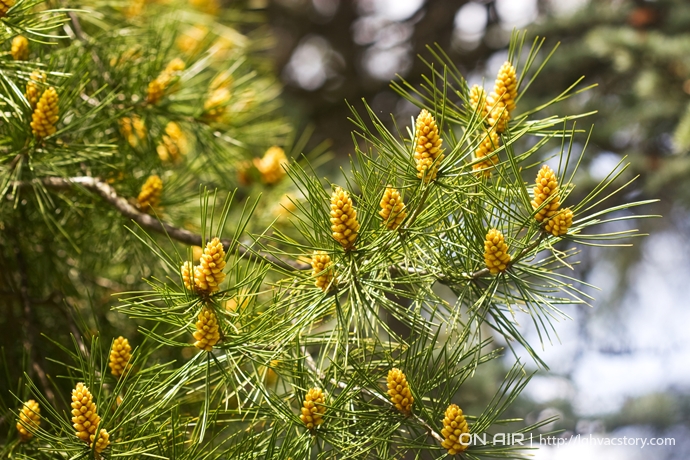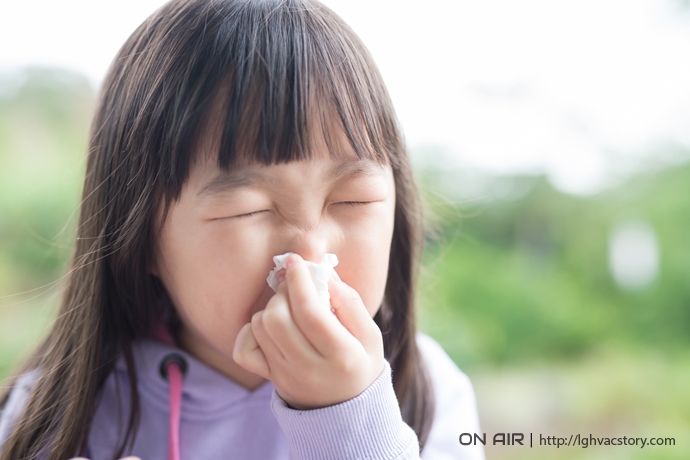Since spring allergies are also a type of disease, the best way to cope with them is to find the cause of the symptoms and get treatment. Let’s take a look at what causes allergies and what to do about them.
The Causes of Spring Allergy Symptoms
Our bodies create immune reactions to protect themselves when invaded by bacteria or viruses. When these reactions become too severe, they’re considered as allergic reactions. In other words, allergy attacks occur when our bodies are reacting too sensitively to minor substances. If pollen gets into your nose, an allergic reaction can happen because your body recognizes it as some kind of toxic gas, and will try to get rid of it by causing nasal discharge and sneezing.

A pine tree emitting pine pollen
The substances that cause allergic reactions are called allergens, and the most common forms of these are pollen, dust mites, animal hair, mold, and cigarette smoke. The allergen most commonly found in spring is airborne pollen from pine, oak, alder, and birch trees.
If you have symptoms like itchy eyes, nose, or throat, sneezing, excessive tears, or a runny nose, you might have an allergy, since pollen causes allergic dermatitis, rhinitis, and asthma. Many people simply think these symptoms are temporary like a cold, and don’t consider visiting a doctor. Allergic reactions like asthma, however, can be severe enough to cause death, so it’s important to receive proper treatment from the beginning.
How to Prevent & Treat Allergic Reactions in Spring

‘Ah-Choo!’
1. Don’t Forget to Carry a Mask
The first thing you need to do is protect yourself from substances and environments that cause allergic reactions. Wear a mask, hat, or sunglasses according to what causes you to have symptoms. If you’re allergic to sunlight, wear long-sleeved shirts and sunscreen to protect your skin. It’s good to shake the clothes you wore outside, wash your nose and eyes, and use enough moisturizer when you come home.
2. Seek Treatment
The best treatment for allergies is medication including antihistaminic agents and steroids. After that there is also immunotherapy. This involves injecting a drug made with certain ingredients extracted from the allergen for a period of time. If a patient is allergic to pollen, a drug made of certain pollen-related ingredients will be injected to improve his or her immunity. This treatment can last from five to ten years. Still, don’t forget to consult your doctor before jumping onto this treatment.
3. Eat Allergy-Preventive Food

Spinach is a rich source of lutein
Light allergic reactions can be prevented by eating lots of immunity building foods. If you’re looking for food which is good for your eyes and immune system, try lutein-rich spinach, salmon with omega-3 fatty acid, and blueberries or grapes for anthocyanin. For those with respiratory problems, try strawberries and tangerines, which are full of flavonoid. How about having these foods for dinner tonight?
4. Check Your Home Environment
Although many people try to block allergens while outside by wearing masks, 65.7% of the allergic reactions happen inside homes. It’s a good idea to clean and examine your VRF air conditioning system before summer, and you can get this done during spring cleaning. See how low your indoor air quality may be, and how to check your HVAC system in the posting below.
|
Related post
CHECKLIST: HOW POLLUTED IS YOUR INDOOR AIR? |
Hospitals also provide tests through which you can see what allergens you react to, and preventing allergic symptoms can be much easier once you know what causes them. I hope you have a healthy spring!


































